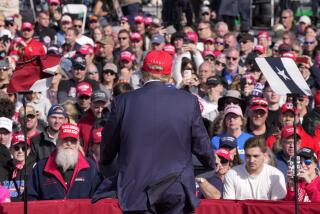Locating a New Credibility Gap Is Not So Easy
Last week’s charges and counter-charges about the Nicaraguan move across the Honduran border set off speculation that the Reagan Administration’s relatively alarmist view endangered its own credibility. But on the historical record, this almost certainly is not the case--at least not in the short run.
The term “credibility gap” entered our vocabulary with the Administration of Lyndon B. Johnson, when White House claims for Vietnam policy were progressively belied by events--or at least by the appearance of events in American eyes. Johnson’s credibility was undermined by the enormous, growing contrast between what he had been understood to say in 1964--”Let Asian boys fight Asians”--and the draft calls, casualties and televised hostilities thereafter, in a war he claimed would lead to satisfactory settlement. It led instead to pictures of the enemy inside the U.S. Embassy, during the 1968 Tet offensive.
By then, Johnson’s every press statement was picked apart by disbelieving journalists. But this was the result, not the cause, of a progressive disillusionment created by the distance between apparent promise and perceived performance. The same sort of phenomenon enveloped Richard M. Nixon after Watergate--The only difference was that Tet was not in fact the defeat it seemed, while Nixon really did have something to hide.
Although we had no term for such losses of credibility earlier in our history, we find them often; for example, after the late spring in 1930, President Herbert Hoover, along with most commentators, pronounced the economic downturn almost over. Soon after, the economy collapsed in a disastrous three-year slide, and with it went his credibility.
For some Presidents the process has gone farther, faster than for others. Some seem to be decidedly more vulnerable. Personality plays a part in this, along with the nature of events themselves and the perceived interaction of the two. President Jimmy Carter’s loss of credibility began with his improvident defense of Thomas Bertram Lance on national television in July, 1977. In turn, Ronald Reagan’s “Teflon” coating--his relative immunity to criticism--owes something, surely, to his gallantry after the attempted assassination of March, 1981. Indeed, it may not be too much to say that what then happened was a fusing of perceived reality with all his “nice guy” images from old movies. Eventually, even the New York Times stopped putting quotation marks around the nickname Gipper.
For some Presidents the process has gone farther, faster than others. Some seem decidedly more vulnerable. Carter was the least lucky President since Hoover; Reagan is the luckiest since Calvin Coolidge. The Reagan-Carter contrast poses also the factor of luck. Carter undoubtably was the least lucky President since Hoover; Reagan the luckiest since Calvin Coolidge.
In short, it is not single statements but the cumulative look of things contrasted with remembered claims (especially if repeated) that threaten credibility for Presidents and lesser officials as well.
Outright distortions, to be sure, can pave the way (as with successive Nixon statements after Watergate), infuriating journalists and others who then sharpen whatever contrasts appear. But recent Administration statements on Sandinista incursions and Honduran reactions are not in the same class, although Honduran claims of pressure from Washington don’t help. At worst, the Administration exaggerated what all sides by now acknowledge. The question affording most perspective would have been: How many incursions, in what strength, come monthly, annually, across that border? Neither the Administration nor its critics have chosen to focus on that.
Compared, say, with Hanoi’s alleged torpedo-boat attack in August, 1965, which precipitated American retaliation and a request to Congress for what became known as the Tonkin Gulf Resolution, the Sandinista incursion of two weeks ago seems to have had considerable substance--even by Managua’s account. For not only did Hanoi deny that the attack had taken place, subsequent investigation suggests probably it didn’t: Washington was misled--willingly--by reports based on ambiguous sonar signals.
Yet not until the Johnson Administration leaned too heavily upon that resolution, indeed tried to treat it as approval for an outright war, did the reality of the initial incidents come under serious question. Not until 1967 did the likelihood of error come to be widely argued as a charge against Administration credibility--and by then what fueled the credibility gap was not such past details--however useful in an argument--but current troubles: the draftees, the dead, the wounded, the war seen on televison--and the protests, too.
And so it is for Reagan. With respect to Central America, what threatens his credibility is prospective, all to come, all cumulative, starting from the base line of his Sunday-night televised address on March 16 and his intense congressional campaign since then. He has painted a picture of “dominoes,” pushed over by Nicaragua, as well as Cuba (on behalf of the Soviets). The biggest domino, Mexico, he says is the target of all, poised to fall across our border. He offers aid to the contras as his means to keep that from happening.
If a credibility gap opens before he leaves office, it will be because his picture sticks in American minds while his means prove to be insufficient, yet he neither defines the threat away nor offers fresh means other than the kind that did in Johnson. Once such a gap had widened, it could be that, in retrospect, the “hype” his people gave the recent Sandinista border crossing would become a stick to beat him with--although that seems unlikely since there will have been so many other crossings and recrossings in the interim--but surely it would not have been what “caused” the gap. Events would have done that, events against the backdrop of those dominoes. Alternatively, events may vindicate him, or anyway spare him. They may at least give him or his successor opportunities to redefine the problem.
More to Read
Sign up for Essential California
The most important California stories and recommendations in your inbox every morning.
You may occasionally receive promotional content from the Los Angeles Times.










